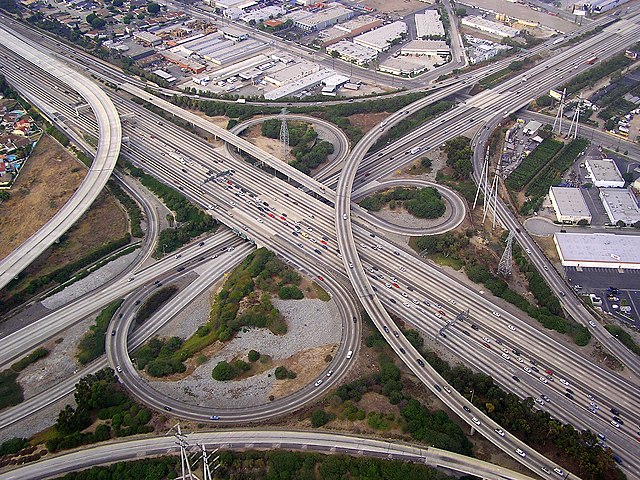37. The Age of Oil (since 1870)
Summary Petroleum products, refined from crude oil, became important fuels since the end of the 19th century and were increasingly used since the end of World War II in 1945, mainly to power automobiles and airplanes. These new vehicles revolutionized the transport of people and goods over short and long distances. The oil-producing countries, such as the United States, the Soviet Union, Saudi Arabia, Iran and Iraq, gained power by using and exporting their black gold, and the fight for access to oil fields became a constant driving force of politics.
Keywords Airplanes; Automobiles; Fossil Fuels; Technology

An oil repository in Moscow, Russia. (© Aleksandr Markin / Wikimedia Commons / CC-BY-SA-2.0)
While coal was the primary fuel of the First Industrial Revolution since about 1760, about a century later petroleum products, as portable and more dense energy products, started to be used more and more often as fuels during the Second Industrial Revolution since about 1870. Not only coal, but also petroleum was formed a few hundred millions of years ago during the Paleozoic Era of Earth’s history. In 1859 the first modern oil well was used by Edwin Drake in the United States to drill for petroleum, which is also called crude oil or simply oil, and which can then be refined to fuels. While oil initially was mainly refined to kerosene for lighting, it was later mainly used to power new means of transportation such as automobiles, which were invented in 1885 by Karl Benz in Germany, or airplanes, which were invented in 1903 by the Wright brothers in the United States. In 1870 the company Standard Oil was founded by John D. Rockefeller, which held a monopoly on the oil market in the United States until its dissolution in 1911 into 34 smaller companies. The access to oil fields became crucial during the wars of the 20th century, including the two world wars, as tanks, ships and fighter jets relied on oil as a fuel. Examples for the importance of the access to oil fields during World War II were the Anglo-Soviet invasion of Iran in 1941, with the aim to secure the Iranian oil fields for the Russian troops, and Germany’s attempt to conquer the Caucasian oil fields in 1942.

A highway interchange in Los Angeles (United States) in the early 21st century. This mass individualized transport would be unthinkable without the extensive consumption of oil. (© User:beglib / Wikimedia Commons / CC-BY-SA-3.0)
The world oil production then rose exponentially from the end of World War II in 1945 until the 1979 oil crisis – in parallel with the spread of automobiles and of mass commercial air travel –, since when it exhibited an overall but slower increase. Initially the United States were the world’s largest oil producer, until they were surpassed by the Soviet Union in the beginning of the 1970s, which in turn was surpassed by Saudi Arabia in the beginning of the 1990s. These three countries – the Soviet Union now mostly being Russia – are still the three largest oil producers today. After it surpassed coal in about 1960, oil was humankind’s primary energy source till now. While petroleum is mainly used for transport, it also revolutionized other fields, such as packaging methods, by the introduction of plastic, and it became a major raw material for the chemical industry.
Part of the increasing oil production also came from the Middle East, to where the petroleum industry expanded from the United States and western Europe since the 1930s. The Ghawar Field in Saudi Arabia, discovered in 1948, is the by far largest conventional oil field in the world. Also the largest natural gas field is located in the Middle East – it is the South Pars/North Dome Gas-Condensate Field, discovered in 1971, which is shared between Iran and Qatar. Also in other countries in that region large oil and gas reserves were discovered, for example in Iraq, Kuwait and in the United Arab Emirates. While from the mid-1940s to the mid-1970s the so-called Seven Sisters – these were seven western oil companies, many of them from the United States and being daughter companies of Rockefeller’s Standard Oil company – controlled about 85% of the worldwide oil reserves, state-owned oil companies gained control over more and more reserves since then, such as Saudi Aramco (Saudi Arabia), Gazprom (Russia), the China National Petroleum Corporation (China) and the National Iranian Oil Company (Iran).
While there have been discussions about when the worldwide peak oil will be reached – the point in time from when on the worldwide oil production decreases due to a shortage of resources –, this point was not reached yet until 2018, partially because of the increased production of unconventional oil in the United States and elsewhere.
